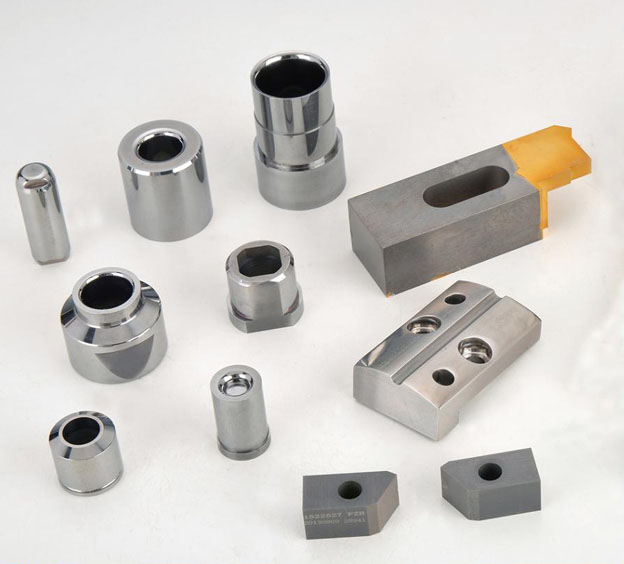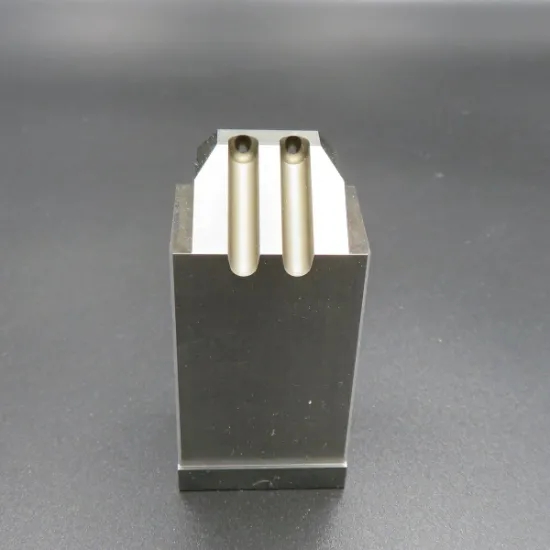The processing of plastic injection mold parts
The main plastic injection mold components contains any parts that come into contact with the plastic parts, which must be precisely processed according to the required accuracy to ensure the efficiency and stability of the injection molding process. These parts include the mold cores, cavity, inserts, lifter and sliders.
The processing for mold core and cavity
1) Preparation of mold materials;
2) Milling machine processing: Drilling and transporting water holes (the distance between the deepest end of the water transporting plug and the horizontal water transporting hole is 3-4mm), threading holes, drilling, tapping screw holes, drilling, pin holes, mold number, reference angle , Give up;
3) CNC machining: rough machining;
4) Heat treatment: indicate the hardness requirements;
5) Grinding machine: Grind a six-sided square, and the size shall be ground to the size of the frame. The dimensions in the upward direction are added to the drawing (minus 0.03mm-0.05mm) ⊥0.01, , 0.01, the part that can be shaped by the grinding machine must be ground and formed;
6) If CNC core machining is required, arrange CNC finishing, if the cavity has fonts and mold numbers, lettering processing is required;
7) Wire cutting processing: middle wire processing insert holes, oblique top holes, thimble holes, pinholes, etc .;
8) EDM processing: single processing according to drawings and pulse instructions;
9) Polishing processing: write the polishing plan and requirements on the process card, use a marker to mark the polished area on the workpiece, if the mirror requirements are too late, you can rough throw the test mold and then finish polishing;
10) Assemble the testing mold.

Injection mold insert processing
1) Preparation of materials: The craftsman defines whether to process a single piece or multiple pieces together according to the size and shape of the workpiece. If multiple pieces are processed together, the craftsman needs to map the processing position of the workpiece;
2) Milling processing: The fitter performs the processing according to the workpiece drawing or the layout chart issued by the technician, drilling and transporting water holes (the deepest part of the water transport plug is 3-4mm from the horizontal water transport hole), threading holes, drilling, Tapping screw holes, drills, pinholes, thickened parts, mold numbers, and concessions.
3) CNC machining: if CNC rough machining is required, arrange CNC rough machining;
4) Heat treatment: indicate the hardness requirements;
5) Grinding machine processing: Grind a six-sided square, the part must be ground and formed;
6) For CNC-finished workpieces, arrange CNC finishing,if the insert has a font and mold number, lettering processing is required;
7) Wire cutting EDM processing: middle wire processing insert holes, oblique top holes, thimble holes, etc .;
8) EDM: single processing according to drawings and pulse instructions;
9) Polishing processing: write the polishing plan and requirements on the process card, use a marker to mark the polished area on the workpiece, if the mirror requirements are too late, you can rough throw the test mold and then finish polishing;
10) Assemble the test mold.

Special-shaped insert processing technology
1) Wire-cutting processing: Medium wire cutting with exact dimensions (A / B view), pull-tab, grinder with thickness allowance, and roughing at the molding place;
2) Grinding machine processing: grind the thickness, slope, forming;
3) EDM processing;
Polishing.
Mold lifts machining
1) Wire cutting processing: the shape of the middle wire cutting, the head is left to the grinding surface and the remaining size is ground, and the remaining dimensions are ground accurately.
2) Grinding machine processing: grind thickness and I-groove;
3) Assembly;
4) EDM processing;
5) Polishing;
6) Milling machine oil groove.

Mold machining of Lift block
1) Fitter preparation: 1.5mm on both sides of the height dimension, 0.5 mm on both sides of the width dimension, and 5 mm on both sides of the length dimension to facilitate wire cutting and clamping;
2) Milling machine processing: drilling and tapping screw holes;
3) Heat treatment processing;
4) Grinding machine processing: Grinding of six-sided square, accurate grinding of width and size;
5) Fast wire cutting process the I-groove standard and pull-tab; thickness grinding machine with remaining margin with height 1.2 mm;
6) Grinding machine processing: The external dimensions of the grinding machine are equipped with a thimble plate, and the height dimension is exactly 1mm.
Lock block processing
1) Prepare materials;
2) Grinding machine processing: Grinding on a six-sided square, the dimensions are accurate;
3) Wire cutting processing; fast wire molding;
4) Milling machine processing: drilling and tapping screw holes.
Ejector hole machining
The above Φ3 (including Φ3, Φ4, Φ5, Φ6) jack holes are processed with milling machine drilling and reaming; below Φ3 or non-standard jack holes, wire cutting is used to avoid the bottom.
Thimble machining
Φ2 and above thimble cutting machines leave a margin for the cutting length of the grinder, and the grinding machine processes the length and size of the grinding standard (the fitter processes it by itself); Flat thimbles and barrels are machined with a wire cutting length and a margin grinder; the grinder is used to grind the length and size accurately.
If we can help you with your project please call us at 0086-769-82821468 or email sales@kaitomould.com.



